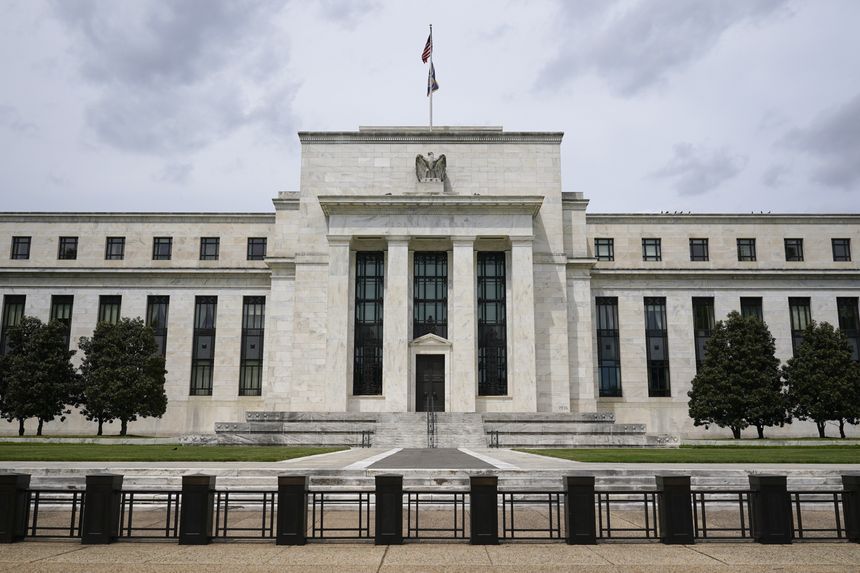
The Federal Reserve’s policies of increasing interest rates and quantitative tightening—reducing its $8.9 trillion balance sheet—will increase the volume and cost of federal government borrowing, slamming the federal budget and exposing the consequences of decades of deficit spending.
The impact will be felt even without a recession, but if the economy does contract, the government will have limited capacity to spur a recovery with fiscal stimulus.
Since February 2020, publicly held U.S. Treasury debt has exploded, growing from about $17 trillion to $24 trillion. Almost half of the increase has wound up at the Fed, whose Treasury holdings have ballooned from $2.5 trillion in February 2020 to $5.8 trillion.
Quantitative tightening is a big initiative. In May the Fed announced plans to reduce its Treasury holdings by $330 billion by the end of the year, and by $720 billion annually thereafter until its balance sheet shrinks to a yet-to-be-determined size. The Fed can reduce its balance sheet, but that doesn’t mean the federal government can reduce its balance of outstanding debt.
Given the extraordinarily low interest rates on new federal debt issued during the recent economic shutdown, federal interest costs barely increased despite the $7 trillion increase in Treasury debt. Over the last three federal fiscal years ending on Sept. 30, 2021, total gross interest cost was $573 billion, $523 billion and $562 billion. (Net interest, after accounting for interest income primarily in government trust accounts, is $150 to $250 billion lower.)
That is changing. Short-term rates have risen 1.5% following the Fed’s 75-basis-point rate increase in June and smaller increases in March and May. By the end of 2022, additional rate increases will bring cumulative rate increases to 3%, according to the Fed’s official guidance. The Fed projects short-term rates averaging 3.4% in December and rising thereafter.
As this additional 3% works its way into the refinancing of maturing Treasurys, federal interest costs will skyrocket. There are about $3.7 trillion outstanding Treasury bills, which mature in less than a year. In 12 months the 3% increase in rates will generate roughly $111 billion in additional annual interest expense on these Treasurys.
There are $2.4 trillion of Treasury notes, which are issued with maturities of one to 10 years, maturing within a year, according to the latest Monthly Report of the Public Debt. The weighted average interest rate on these notes is 1.3%, and the weighted average original maturity is 4.7 years. The current yield on five-year Treasury notes is about 3.25%—1.5 points higher than the high end of the fed-funds-rate range. If these maturing Treasury notes roll over at the same spread over the projected year-end fed funds rate of 3.4%, they will bear interest at 4.9% and cost an additional $86 billion.
Total federal gross interest cost over the 12 months ending on May 31 was $666 billion. If we include the impending extra interest on Treasury bills and the maturing notes, that figure rises to $863 billion. This is a staggering cost. National military spending was $746 billion over the past 12 months; Medicare spending was $700 billion.
With the federal government in perpetual deficit, where will the Treasury find money to make extra interest payments? New taxes? Lower spending? Fat chance. In all likelihood, it will have to borrow to pay interest.
Who will buy Treasurys? Under quantitative tightening, the Fed isn’t planning to reduce its holdings of Treasury bills, only of longer-term notes and bonds. Buyers—especially of long bonds—face an uncertain inflation outlook. The high pace of the Fed’s reduction of its Treasury holdings will require a fast-paced refinancing program. It will be challenging and costly to find buyers to replace the Fed.
The revenue side doesn’t look much better. The sharp selloff in equity markets will severely depress capital-gains tax revenue, which averages more than 10% of federal individual income-tax revenue. Such revenue is now reversing from a historic peak in 2021. The shortfall in 2022 could be as much as $250 billion. Almost inevitably, this revenue loss will have to be made up with more federal borrowing.
Fed policy changes will have other significant effects. In 2021 the Fed generated nearly $108 billion in profit. Big banks make big money. The Fed is required to remit most of its profits to the Treasury. As the Fed shrinks, it will remit less.
Under current Fed policy, the federal government’s annual gross interest expense could reach $1 trillion, causing federal borrowing to continue to grow rapidly. As rates rise and federal borrowing increases, a vicious circle will produce ever more interest expense and ever more borrowing.
This dire outlook has been long coming. The current debate about inflation and whether the Fed’s monetary moves have been too late or too aggressive misses the point. The U.S. has been on an unsustainable fiscal and financial path for a long time. We are beginning to see the inevitable result.
Read the full column in The Wall Street Journal
![]()
Red Jahncke is a nationally recognized columnist, who writes about politics and policy. His columns appear in numerous national publications, such as The Wall Street Journal, Bloomberg, USA Today, The Hill, Issues & Insights and National Review as well as many Connecticut newspapers.


